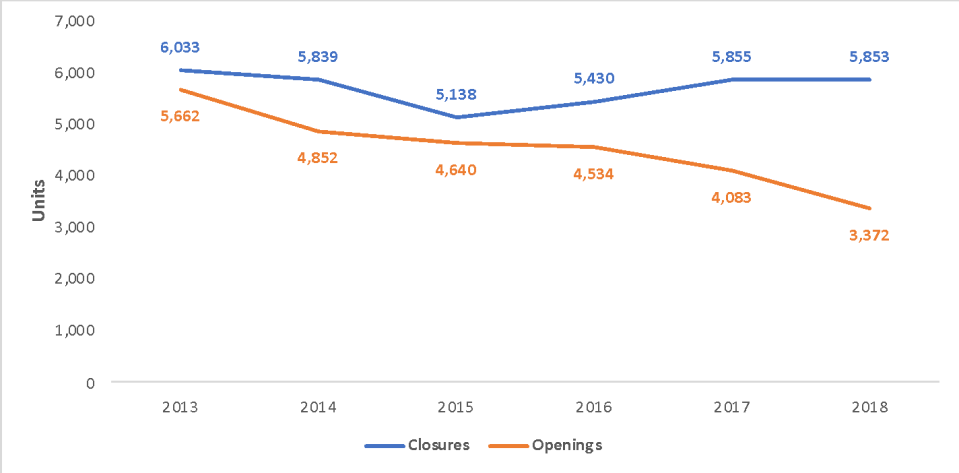A record number of stores disappeared from Britain's high streets in 2018

Stores are disappearing from Britain’s struggling high streets at the fastest rate in almost 10 years, as customers switch to online shopping.
A record 2,481 shops disappeared from the UK’s top 500 high streets in 2018, according to new research from PricewaterhouseCoopers (PwC), compiled by the Local Data Company.
A total of 3,372 new shops opened last year, while far more — 5,833 — closed, according to PwC. The overall loss was over 50% more than that of the previous year, when a net value of 1,772 stores were lost.
READ MORE: A new round of £50,000 loans is coming to help UK high streets
British high streets are in major crisis, with sales at their lowest since 2008. Department store Debenhams announced this week that it has gone into administration, not long after shutting down 50 branches due to a record annual loss in 2018.
House of Fraser, Marks & Spencer, Homebase, Poundworld, Toys R Us, Maplin, Mothercare, Carpetright, New Look, and Gourmet Burger Kitchen are among the many other chains that have been affected.
The rate of store closures in 2018 remained at 16 stores a day, the same as in 2017. However, the shortfall between openings and closures reached its highest level since the beginning of the decade, as withdrawals from the high street were further dented by a historic low number of store openings.
READ MORE: ASOS profits plunge 87% after discounting, website issues
The number of store openings by multiple retailers on the top British 500 high streets has dropped by 17.4% year-on-year, with the current rate of openings at just nine stores per day. This is almost half the levels of five years ago, when the rate was 16.
The figures do not include independent outlets.

Retailers and service providers suffered the biggest declines, with fashion, value, and electrical businesses among those most affected. Just 347 clothing stores opened in 2018, compared with 616 closures — meaning 269 stores were lost.
Traditionally store-based services like banks, estate agents, and recruitment agencies, whose business is increasingly undertaken remotely, also took a hit. PwC found that these categories alone accounted for a reduction of 473 stores on the top 500 high streets last year.
In addition, there were 107 less restaurants and pubs on Britain’s high streets by the end of the year.
READ MORE: What is the future for Britain’s high streets?
Lisa Hooker, consumer markets leader at PwC, pointed to structural trends in consumer habits as the leading cause of decreased store openings.
“In categories as diverse as fashion and financial services, new entrants are able to gain share by launching online — enabled by technology and consumer adoption of mobile and e-commerce — rather than be saddled with the costs and risks of opening on the high street,” Hooker said.
However, there was growth in gyms, bookshops, and places offering sweet treats, PwC found. A net total of 28 more sports and health clubs opened on British high streets, as well as 18 bookshops and ice cream parlours, and 11 cake shops.
READ MORE: Five ways to save Britain’s high streets before it’s too late
There are also 14 more vape and tobacco outlets on British high streets as of last year.
This, in addition to initiatives to bring more shared office shapes and homes into what were traditionally shopping areas, is a sign that high streets are starting to “pivot away from retail” in order to survive, the company explained.
“The high street of the future will be a more diverse space, not solely dependent on stores,” Hooker said.
READ MORE: Mike Ashley urges tax on internet retailers to save high street
“However, it’s clear that the rate of openings is not currently enough to offset the closure of traditional retailers and services, so some tough decisions will need to be taken in the next few years.”
Overall, only 15 out of 100 business types saw growth in outlets in 2018. Categories traditionally among the risers in previous years, such as coffee shops, food to go, takeaways, jewellers, and beauty shops, all suffered net declines as overcapacity and economic conditions “took their toll”, according to PwC.

 Yahoo Finance
Yahoo Finance 